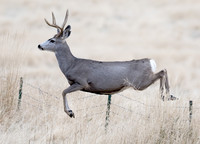Cloudy, 31° F
Wyoming Gov. Matt Mead and Department of the Interior Secretary Ryan Zinke have come together to help protect designated mule deer migration corridors in Wyoming.
They announced last week that …
This item is available in full to subscribers.
The Powell Tribune has expanded its online content. To continue reading, you will need to either log in to your subscriber account, or purchase a subscription.
If you are a current print subscriber, you can set up a free web account by clicking here.
If you already have a web account, but need to reset it, you can do so by clicking here.
If you would like to purchase a subscription click here.
Please log in to continue |
|


Wyoming Gov. Matt Mead and Department of the Interior Secretary Ryan Zinke have come together to help protect designated mule deer migration corridors in Wyoming.
They announced last week that the department will prioritize the conservation efforts by deferring sales of mineral rights and putting lease stipulations on public land. The Bureau of Land Management (BLM) will defer nearly 5,000 surface acres from potential oil and gas developments which intersect the Red Desert to Hoback big game migration corridor in southwest Wyoming.
“Balancing the conservation of habitat and the responsible development of resources ensures the best outcome for the people and wildlife that rely on our federal lands,” Zinke said in a release announcing the decision. “I’m thankful to Gov. Mead for his commitment to my vision for protecting big game corridors and multiple use of federal lands.”
The recent action to deny leases and ask that infrastructure be built outside of the corridor was initiated by the Wyoming Game and Fish Department, which designated those areas are migration corridors two years ago.
After oil and gas companies proposed leasing some public lands in those areas — and the minerals rights were scheduled to be leased in the BLM’s quarterly sale — representatives for the Game and Fish poured over the maps and identified leases in conflict with the corridor, said Scott Smith, deputy director of the Game and Fish
“We requested the BLM not issue those leases that were entirely in the corridor and minimize infrastructure if the lease overlapped into the corridor,” Smith said.
Gas and oil companies will still be allowed to drill on the border leases, just not build within the boundaries of the corridor, he said. The BLM agreed with the assessment, along with Mead and Zinke, and the leases were altered or denied to minimize extraction impacts on the habitat and to maintain big game migration corridor functionality.
“This decision gives the public and those involved in the Rock Springs Resource Management Plan Revision time to work on steps that balance wildlife needs with energy development needs,” Mead said. “Wyoming will continue to work with the Department of the Interior to strike that balance.”
The recent decisions follow closely Secretarial Order 3362, signed last year by Zinke. The order directs appropriate bureaus within the DOI to work in close partnership with the western states, including Wyoming, to enhance and improve the quality of big-game winter range and migration corridor habitat on federal lands in a way that recognizes state authority to conserve and manage big-game species and respects private property rights.
Protecting habitat in the corridor is a move in the right direction, said Josh Coursey, president and CEO of the Muley Fanatic Foundation.
“While the vast majority of Americans support multiple use of public lands, and much of our economies thrive on oil and gas, it’s important to balance development and conservation,” Coursey said. “The migration corridor initiative ... will do just that: balance the needs of wildlife and those who love public lands with our needs for energy.”
Coursey is concerned with a nearly 40 percent decline in mule deer populations over the past two decades. The foundation was instrumental in lobbying the state and Department of the Interior to develop and respect the corridor. Coursey just returned from a lobbying trip to Washington, D.C., in an effort to bring the issue to national leaders.
“In this energy-dominated mindset, all stakeholders need to continue making noise,” Coursey said. “This is no time to rest.”
Coursey said wildlife is a large part of the tourism economy of the state.
“Yellowstone [National Park] is a beautiful place, but if you remove the wildlife, people will stop coming,” he said, making an analogy for the rest of the state.
The foundation also funds projects to help recovery efforts, said Smith, with the Game and Fish.
“Their fundraising leads to dollars on the ground for local projects,” he said.
But it’s not the only challenge the species is currently facing. The prevalence of chronic wasting disease (CWD) is on the rise in the Big Horn Basin, said Renny MacKay, communications director for the Game and Fish. Last year saw some firsts: a case of CWD found in a new Park County hunt area near Meeteetse and the first case of CWD ever found in Montana was taken south of Bridger.
The Montana sample was collected from a mule deer buck harvested by a hunter in late October last year. The appearance of CWD in Montana is unwelcome, but not a surprise. CWD had been found in all its border states and Canada.
“Prevalence is on the increase and we’re finding it in new places every year,” MacKay said.
In Park County, the prevalence of CWD is low, said Cody region wildlife biologist Tony Mong. Less than 1 percent of the deer in the Upper Shoshone River area have tested positive for the disease. Yet herd size is still lower than what is hoped, Mong said.
“Deer populations are all below where we’d like them to be,” Mong said.
Regulations and testing for disease has ramped up in the recent years. This year there is a 4-point restriction on bucks in the Cody region and the general season is for bucks only. The regulations should help, Mong said.
“It helps younger bucks to reach maturity and with the 4-point restrictions, we typically see a decrease in hunter participation,” Mong said.
Mong will oversee the Cody check station for three weeks this fall, testing all deer brought in.
Game and Fish personnel collected and tested more than 3,350 CWD samples throughout the state in 2017, a significant increase from past few years. The Game and Fish commission also invested $2.5 million for a five-year initiative to study mule deer and work to improve habitat.
As part of the initiative, an assistant professor at the University of Wyoming’s Haub School of Environment and Natural Resources, Kevin Monteith, has been working on a study of mule deer. His work is part of ongoing efforts to understand the decline of mule deer in the state.
“We just don’t have the abundance that we used to,” Monteith said.
In Monteith’s work, he has found many factors affecting mule deer populations. They include predation, weather, competition with elk and other ungulates, mineral extraction, hunting and disease. Yet there is one factor more important than the rest, he said at a recent Game and Fish Commission meeting:
“There’s ultimately one piece, that if it’s missing, none of the rest of those pieces matter. [Habitat] is truly the foundation and building block for population,” Monteith said.
There have been modest gains in mule deer populations in the past two years, MacKay said. But he hesitated to claim victory for habitat improvements.
“They are short-term increases and mostly due to good weather,” he said.
The migration corridor concessions are a step in the right direction to quality habitat, Smith said.
“We make recommendations to the federal agencies and in this case it had a positive outcome,” Smith said.